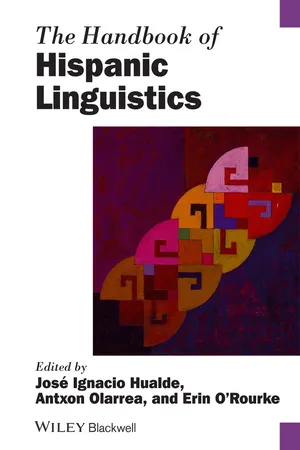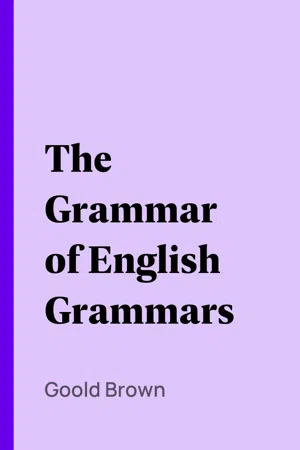Indefinite Pronouns
Indefinite pronouns are a type of pronoun that do not refer to a specific person, thing, or amount. They are used to refer to non-specific or unidentified people or things. Examples of indefinite pronouns include "someone," "anything," "everyone," and "nothing." These pronouns are used to generalize and make statements about an unspecified quantity or identity.
5 Key excerpts on "Indefinite Pronouns"
- eBook - ePub
Definiteness and Indefiniteness
A Study in Reference and Grammaticality Prediction
- John Hawkins(Author)
- 2015(Publication Date)
- Routledge(Publisher)
...But (b) claims only that there may or may not be other solutions, and is, therefore, non-committal about the existence of other such objects. The data which we have considered using indefinites can be said to require that there are other possible referents in the sense of (a), and not in the sense of (b). Explaining the Logical Contrast between Definiteness and Indefiniteness We see now that indefinite descriptions do not contrast pragmatically with definite descriptions in the sense that indefinite referents are not locatable in speaker-hearer shared sets. Instead, the contrast is of a more logical kind: exclusiveness, or reference to not-all, versus inclusiveness, or reference to all. Why should the contrast be this way? We have argued that referring predicates have a potential for infinite reference. This potential can be fully realised by using a universal quantifier, all or every. The effect of using a definite article was, we argued, to impose a pragmatic blanket on the potentially infinite number of referents of a referring expression by instructing the hearer to exploit shared knowledge and the shared situation in reducing this infinity to something finite. All the potential referents falling outside this blanket are excluded as irrelevant, and the definite article refers inclusively to all the relevant objects falling under it. But the indefinite articles are neutral to these pragmatic pre-suppositions of the. It is, therefore, no part of their actual meaning that the domain of reference relative to which the hearer can interpret the indefinite description is being pragmatically restricted, even though indefinite referents may, context permitting, be optionally located in a shared set on some occasions...
- eBook - ePub
- Jenneke A. Oosterhoff(Author)
- 2009(Publication Date)
- Routledge(Publisher)
...UNIT SIX Indefinite Pronouns Introduction This unit is an introduction to the most commonly used Indefinite Pronouns. Indefinite Pronouns refer to unspecified people or things. For information on indefinite numbers, check Unit 4 of Basic Dutch. Indefinite Pronouns men one iemand someone je one niemand no one ze they iets, wat something we we (in general) niets, niks nothing al all elk(e) each, every alle(n) all ieder(e) each, every alles everything iedereen everyone allemaal all Men, je, ze, we The indefinite pronoun men is used to make general, rather formal statements. It can only be used in the subject position, and the verb form is singular. Examples: Men mag hier niet roken. Smoking is prohibited. Men zegt dat Napoleon hier geslapen heeft. They say that Napoleon slept here. In a statement with men, the emphasis lies on the action rather than the agent of the action. In Dutch, such statements are often expressed in the passive form. Compare: Men mag hier niet roken. Passive: Hier mag niet gerookt worden. Men zegt dat Napoleon hier geslapen heeft. Passive: Er wordt gezegd dat Napoleon hier geslapen heeft. The pronoun men is primarily used in formal speech. In less formal speech, Dutch uses the pronouns je, ze and we. While men can only be used in the subject position in the sentence, je can take both the subject and object positions. Examples: In dat restaurant kun je heerlijk eten. One can have delicious meals in that restaurant. Als je (subject) een beetje extra betaalt, laat een gids je (object) de hele stad zien. If you pay a little extra, a guide will show you the whole city. A sentence with indefinite je includes the speaker and the listener and is therefore more personal. However, using indefinite je is not always possible. In some contexts, indefinite je could create confusion with the personal pronoun je...
- eBook - ePub
Grammar, Meaning, and Concepts
A Discourse-Based Approach to English Grammar
- Susan Strauss, Parastou Feiz, Xuehua Xiang(Authors)
- 2018(Publication Date)
- Routledge(Publisher)
...What does this suggest about potential variety in reference terms in written discourse? Are there any pronouns or determiners that appear in this passage that refer to different entities (e.g., his, they, them, their)? How can you tell which of these pronouns or determiners refers back to which antecedents in the discourse? 5.2 More on Pronouns and Reference: Conceptual Meanings and Assumptions As with all aspects of grammar, there are a number of broader assumptions that underlie the use of pronouns, especially with regard to conceptual meanings and referential scope. 5.2.1 The Use of Pronouns Assumes Shared or Given Information Regarding Referents Readers and hearers assume that the referents marked by a pronoun (rather than a full noun phrase or a proper noun) are sufficiently recognizable—either through prior mention, common knowledge, or upcoming future mention...
- eBook - ePub
- José Ignacio Hualde, Antxon Olarrea, Erin O'Rourke, José Ignacio Hualde, Antxon Olarrea, Erin O'Rourke(Authors)
- 2012(Publication Date)
- Wiley-Blackwell(Publisher)
...The problem is how to obtain a precise characterization of the predicates that reject semantic incorporation. It is not entirely clear that the notion of individual-level predicate is the right one (see Laca and Dobrovie-Sorin 2003 and Cohen and Erteschik-Shir 2002 for some criticism). Much work is still needed on the relationship between lexical semantics and types of semantic incorporation, although research along the lines of Espinal (2010) and Espinal and McNally (2011) seems to be particularly promising. 3 Indefiniteness 3.1 The indefinite article Most grammatical properties of indefinite determiners in Spanish are shared with the rest of the Romance languages and, generally, with all languages whose determiner system encodes the semantic distinction between definiteness and indefiniteness (in particular, those that possess an indefinite article). The core issues in a description of Spanish are the role of the indefinite article un and its plural form unos, the existence of epistemic and modal indefinites like algún ‘some,’ and the gradual conversion of a number of adjectives into indefinite determiners (cierto ‘a certain,’ otro ‘another,’ bastante ‘enough’). Here I will briefly review some recent contributions to the field (see Chapter 16 for general considerations on indefinite quantifiers). The indefinite article shows the widest distribution of all indefinites: it can receive specific, non-specific, cardinal and generic readings (Leonetti 1999; RAE 2009: §15), and its meaning is limited to the absence of definiteness (i.e., the absence of a uniqueness/familiarity requirement)...
- eBook - ePub
- Goold Brown(Author)
- 2004(Publication Date)
- Perlego(Publisher)
...1. A pronoun is a word used in stead of a noun. 2. A personal pronoun is a pronoun that shows, by its form, of what person it is. 3. The first person is that which denotes the speaker or writer. 4. The singular number is that which denotes but one. 5. The neuter gender is that which denotes things that are neither male nor female. 6. The objective case is that form or state of a noun or pronoun which usually denotes the object of a verb, participle, or preposition. Thus is an adverb. 1. An adverb is a word added to a verb, a participle, an adjective, or an other adverb; and generally expresses time, place, degree, or manner. LESSON I.—PARSING. "Every man has undoubtedly an inward perception of the celestial goodness by which he is quickened. But, if to obtain some ideas of God, it be not necessary for us to go beyond ourselves, what an unpardonable indolence it is in those who will not descend into themselves that they may find him?"— Calvin's Institutes, B. i, Ch. 5. "Jesus answered, If I honour myself, my honour is nothing: it is my Father that honoureth me; of whom ye say, that he is your God: yet ye have not known him; but I know him."— John, viii, 54. "What! have ye not houses to eat and to drink in? or despise ye the church of God, and shame them that have not? What shall I say to you? shall I praise you in this? I praise you not."— 1 Cor., xi, 22. "We know not what we ought to wish for, but He who made us, knows."— Burgh's Dignity, Vol. ii, p. 20. "And who is he that will harm you, if ye be followers of that which is good?"— 1 Peter, iii, 13. "For we dare not make ourselves of the number, or compare ourselves with some that commend themselves: but they, measuring themselves by themselves, and comparing themselves among themselves, are not wise."— 2 Cor., x, 12. "Whatever is humane, is wise; whatever is wise, is just; whatever is wise, just, and humane, will be found the true interest of states."— Dr. Rush, on Punishments, p...




